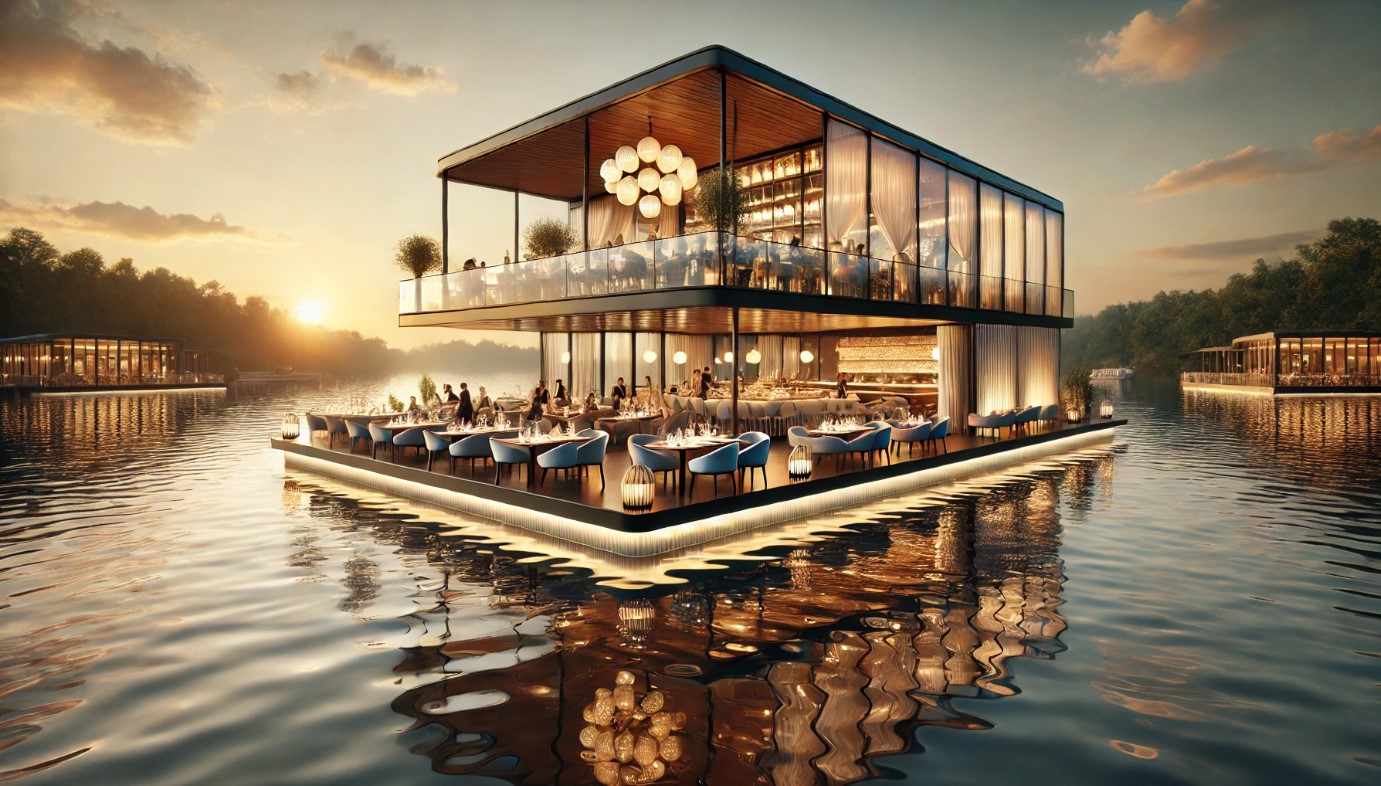In the ever-evolving landscape of sustainable living, floating gardens have emerged as a brilliant confluence of art and science. These verdant oases, gracefully perched upon the water’s surface, offer more than just aesthetic appeal; they embody a harmonious integration of nature into our living spaces, promoting ecological balance and enhancing the quality of life. As we delve into the world of floating gardens, we uncover their beauty and explore the profound ecological benefits they bring to aquatic living environments, particularly in the burgeoning concept of floating Aqua Urban communities.

The Art of Floating Gardens: Aesthetic Harmony
Designing a floating garden requires a delicate balance between form and function. The layout must be carefully planned to ensure that the garden remains stable and buoyant while maintaining its visual appeal. Plants are selected not only for their beauty but also for their adaptability to aquatic environments. These gardens often feature a mix of native and ornamental plants, which can include everything from flowering species like water lilies and irises to grasses and sedges that sway gently with the water’s movement.

Incorporating elements such as floating pathways, seating areas, and even art installations can elevate the garden’s aesthetic impact, making it a focal point in any aquatic setting. The interplay of water, plants, and light creates a dynamic, ever-changing landscape that invites contemplation and relaxation.

The Science of Floating Gardens: Ecological Benefits
Beyond their visual charm, floating gardens play a critical role in promoting ecological health. They are more than just decorative features; they are functional ecosystems that contribute to the well-being of aquatic environments.
One of the primary ecological benefits of floating gardens is their ability to improve water quality. The roots of the plants dangle beneath the floating structure, absorbing excess nutrients such as nitrogen and phosphorus from the water. These nutrients, often the result of agricultural runoff or urban pollution, can lead to harmful algal blooms that deplete oxygen levels and threaten aquatic life. By removing these nutrients, floating gardens act as natural biofilters, helping to maintain a healthy balance in the water.
Moreover, floating gardens provide essential habitat for wildlife. Fish, birds, and insects find refuge among the plants, which offer shelter, breeding grounds, and food sources. The shade created by the garden also helps regulate water temperature, benefiting fish and other aquatic species that thrive in cooler environments.

As the concept of floating Aqua Urban communities gains momentum, the integration of floating gardens becomes increasingly significant. These communities, designed to exist harmoniously with water, are the perfect environment for floating gardens to thrive. By incorporating these green spaces into the design of floating cities, we can create healthier, more sustainable living environments that not only support human life but also nurture the surrounding aquatic ecosystems.

The ecological benefits of floating gardens extend beyond the water’s edge. Floating gardens can mitigate the effects of climate change by capturing and storing carbon dioxide. The plants absorb CO2 as they grow, sequestering carbon in their biomass and contributing to the reduction of greenhouse gases in the atmosphere. In urban settings, where green space is often limited, floating gardens can help combat the urban heat island effect by cooling the surrounding air and providing much-needed green space.

Integrating Floating Gardens into Aqua Urban Communities
The concept of floating gardens is not new; they have been used for centuries in various cultures, from the chinampas of the Aztecs (regarding which we cover in our previous articles Ancient Water-Based Communities: A Look Back at History and Lessons for the Future and also in Ocean Farming: The Blue Revolution Feeding the Future) to the floating farms of Bangladesh. However, recent advances in materials and design have made it possible to integrate these gardens into modern aquatic living spaces more effectively than ever before.
For those living on houseboats, in floating homes, or in waterfront properties, floating gardens offer a unique opportunity to enhance their connection with nature. But their potential reaches far beyond individual homes. In the context of floating Aqua Urban communities—self-sufficient, water-based cities of the future—floating gardens can play a crucial role in urban planning and development.

These gardens can be designed to serve specific functions within these communities, such as growing edible plants, creating wildlife habitats, or providing communal spaces for residents to gather and connect with nature. By strategically placing floating gardens throughout a floating city, we can create green corridors that connect different parts of the community, enhance public spaces, and provide residents with access to nature, all while improving the overall ecological health of the water bodies they inhabit.

Case Study:
Floating Farms of Bangladesh
In Bangladesh, an ancient and still-practiced form of floating agriculture can be found. This method is particularly prevalent in the southern delta region of the country, which is prone to seasonal flooding.

How Floating Farms Work:
- Construction: Floating farms, or baira, are constructed by weaving together water hyacinth and other aquatic plants to form a raft-like structure. This raft is then layered with soil, compost, and organic matter to create a bed suitable for planting.
- Crops: Common crops grown on these floating beds include vegetables like gourds, okra, and leafy greens, as well as spices and herbs. Farmers also sometimes use these beds to start seedlings, which are later transplanted to more stable land.
- Mobility: One of the key benefits of these floating farms is their mobility. Since they float on the water, they rise and fall with the water levels, making them particularly resilient to the seasonal monsoon floods that affect the region.
- Environmental Adaptation: This method allows farmers to continue growing crops even during the rainy season when much of the land is underwater. It is an ingenious adaptation to the challenging environmental conditions of the region.
The floating farms of Bangladesh not only provide food security for local communities but also represent a sustainable agricultural practice that makes efficient use of the available water resources. In recent years, there has been a resurgence of interest in this traditional practice as a model for climate change adaptation, particularly in regions vulnerable to flooding.

Phumdis – The Unique Floating Gardens of Manipur
Phumdis are a fascinating example of natural floating islands, primarily found in the Loktak Lake in the Indian state of Manipur (regarding which we cover in our previous article Ancient Water-Based Communities: A Look Back at History and Lessons for the Future). These floating masses are not only significant for their ecological and cultural value but also for the unique form of agriculture they support. Phumdis are naturally occurring floating islands made up of a heterogeneous mass of vegetation, soil, and organic matter. These formations float on the surface of Loktak Lake and are a vital part of the lake’s ecosystem.

In addition to their ecological importance, phumdis are also used for a unique form of agriculture practiced by the local communities living around Loktak Lake. This practice is deeply intertwined with the culture and livelihood of the people in the region.
One of the most remarkable aspects of phumdis is their role in Keibul Lamjao National Park, which is the world’s only floating national park. This park is located on a large phumdi and is home to the endangered Sangai deer (Manipur brow-antlered deer), also known as the dancing deer due to its delicate, almost dance-like movements.

Conclusion: A Vision for the Future
Floating gardens represent a perfect blend of art and science, where the beauty of nature meets the principles of ecology and design. They offer a sustainable solution for enhancing aquatic living spaces, providing both aesthetic pleasure and ecological benefits. As we move towards a future where water-based living becomes more common, particularly in the form of floating Aqua Urban communities, the role of floating gardens will undoubtedly grow, offering a glimpse into a world where humans and nature coexist in perfect harmony.
By embracing the art and science of floating gardens within these communities, we not only create beautiful, living waterscapes but also contribute to the health of our planet. These gardens remind us that even in the most modern of settings, nature has a place—and it is our responsibility to nurture and protect it.




